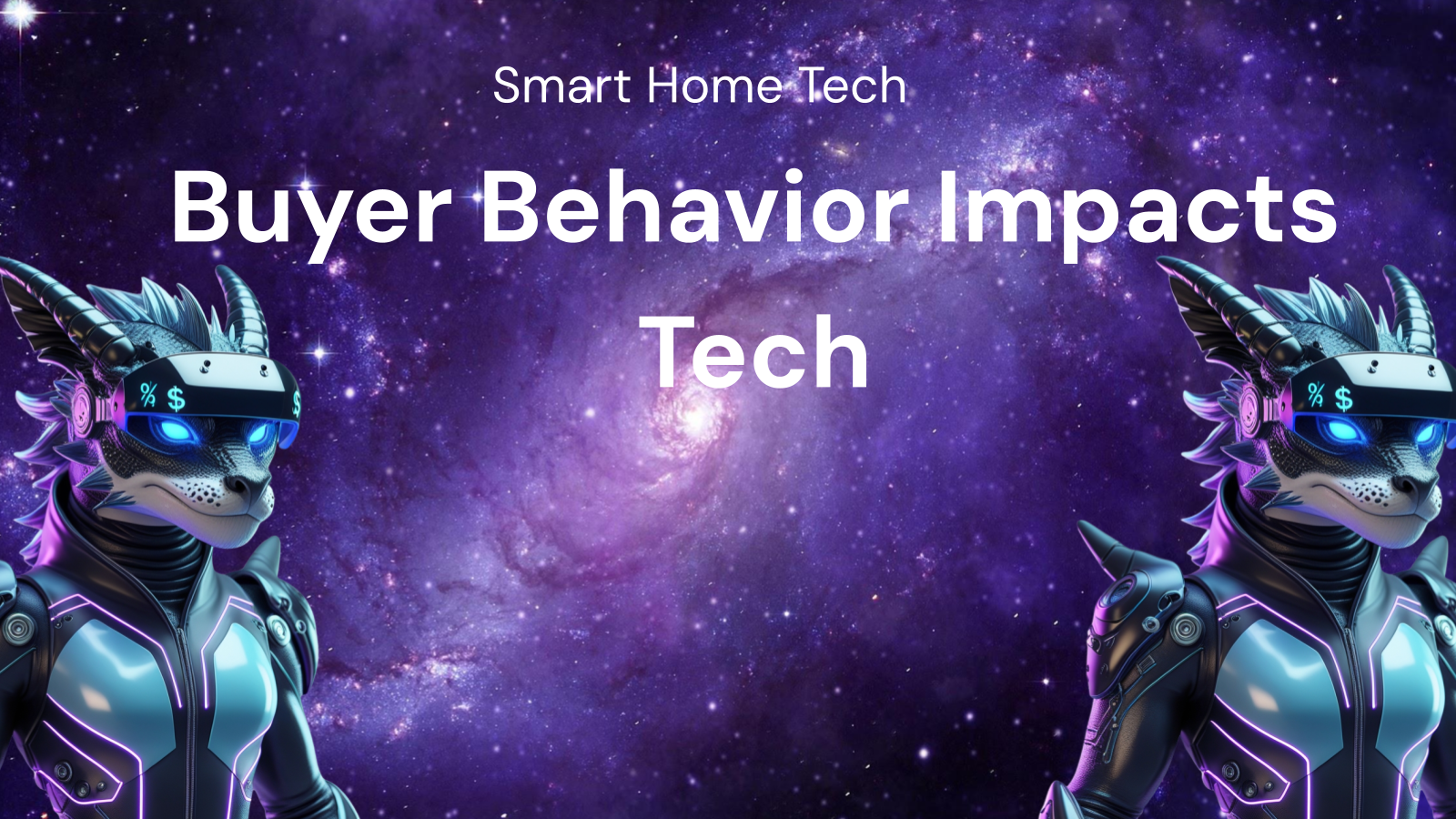How Buyer Behavior Impacts Choosing Smart Home Tech

How Buyer Behavior Impacts Choosing Smart Home Tech
The smart home market is booming. From voice assistants to connected appliances, the promise of a more convenient, secure, and efficient living space has captured the imagination of homeowners worldwide. However, with a plethora of devices and platforms vying for attention, navigating this landscape can be overwhelming. The key to successful smart home adoption lies not just in the technology itself, but in understanding the buyer behavior that drives purchasing decisions.
This blog delves into the crucial connection between buyer behavior and the selection of smart home tech. We'll explore various psychological factors, motivations, and influences that shape consumer choices, providing valuable insights for both potential buyers and smart home vendors. By understanding why people buy smart home devices, we can better understand what they'll buy, and how to effectively market and implement these technologies for maximum impact.
I. Understanding the Smart Home Buyer Landscape:
Before delving into specific behavioral aspects, it's crucial to recognize the diverse segments within the smart home buyer market. These segments differ in their motivations, technological expertise, budgets, and desired outcomes. Some key segments include:
- The Early Adopters (Tech Enthusiasts): These individuals are drawn to innovation and are eager to experiment with the latest gadgets. They are often well-informed about technology, comfortable troubleshooting issues, and willing to invest in cutting-edge solutions. They are driven by a desire to be at the forefront of technological advancement and often prioritize functionality and integration over price.
- The Convenience Seekers: This group prioritizes simplifying their daily routines and making their lives easier. They are attracted to smart home devices that offer automation, remote control, and voice-activated convenience. They are less concerned with the underlying technology and more focused on the practical benefits. Examples include smart lighting, automated blinds, and voice-controlled entertainment systems.
- The Security Conscious: This segment is primarily motivated by enhancing their home security and safety. They seek devices like smart locks, security cameras, and alarm systems that provide real-time monitoring, remote access, and peace of mind. They are often willing to invest in robust and reliable systems with advanced features like facial recognition and professional monitoring services.
- The Energy Savers (Eco-Conscious): Driven by environmental concerns and the desire to reduce energy costs, this group invests in smart thermostats, smart lighting, and energy monitoring systems. They are interested in data-driven insights that help them optimize their energy consumption and reduce their carbon footprint.
- The Budget-Minded Beginners: This segment is just starting their smart home journey and is looking for affordable and easy-to-use solutions. They may be hesitant to invest heavily in complex systems and prefer to start with a few essential devices like smart plugs or a basic voice assistant.
Understanding these distinct segments allows vendors to tailor their marketing messages, product offerings, and customer support to resonate with specific needs and desires.
II. Key Psychological Factors Influencing Smart Home Purchases:
Several psychological principles play a significant role in shaping buyer behavior in the smart home market.
- Perceived Value: Consumers evaluate the perceived value of a smart home device by weighing its benefits against its cost (both financial and non-financial). Benefits include convenience, security, energy savings, entertainment, and enhanced lifestyle. Costs include the purchase price, installation costs, ongoing maintenance, learning curve, and potential privacy concerns. If the perceived benefits outweigh the perceived costs, the consumer is more likely to make a purchase.
- Loss Aversion: People are generally more motivated to avoid losses than to acquire gains. This principle is particularly relevant for security-related smart home devices. Marketing messages that highlight the potential consequences of not having a smart security system (e.g., theft, burglary, fire) can be more effective than simply emphasizing the benefits of increased security.
- Social Proof: Consumers are influenced by the actions and opinions of others, especially those they trust or admire. Positive reviews, testimonials, and endorsements from influencers can significantly impact purchase decisions. Social proof also extends to the adoption rate of smart home technology in general. As more people embrace smart home devices, the perceived risk of adoption decreases, and more consumers are likely to follow suit.
- Cognitive Dissonance: This refers to the mental discomfort experienced when holding conflicting beliefs or attitudes. Smart home purchases can trigger cognitive dissonance if the consumer experiences buyer's remorse after purchasing a device that doesn't meet their expectations. To reduce dissonance, consumers may seek out positive information about their purchase, justify their decision, or downplay the negative aspects of the product. Vendors can help mitigate cognitive dissonance by providing clear and accurate product information, offering excellent customer support, and providing hassle-free return policies.
- Framing Effect: The way information is presented can significantly influence consumer perception and decision-making. For example, framing a smart thermostat as a way to "save 20% on your energy bill" can be more appealing than framing it as "reducing your energy consumption by 20%." The framing effect highlights the importance of crafting persuasive marketing messages that resonate with consumer values and aspirations.
- The Endowment Effect: This refers to the tendency for people to place a higher value on things they own, even if they acquired them recently. Once a consumer has invested in a smart home ecosystem (e.g., Amazon Alexa or Google Home), they are more likely to continue purchasing devices compatible with that ecosystem, even if other options are technically superior. This creates a "stickiness" effect that can benefit vendors who can establish a dominant position in the smart home market.
III. Motivations Driving Smart Home Adoption:
Understanding the underlying motivations that drive smart home adoption is critical for tailoring marketing efforts and product development. Some key motivations include:
- Convenience and Automation: This is perhaps the most prominent driver of smart home adoption. Consumers are drawn to devices that simplify their daily routines, automate repetitive tasks, and provide remote control over various aspects of their home. Examples include automated lighting, smart appliances that can be controlled remotely, and voice-activated assistants that can perform a wide range of tasks.
- Security and Safety: Enhanced home security is a significant motivator for many buyers. Smart locks, security cameras, and alarm systems provide real-time monitoring, remote access, and alerts in case of emergencies. These devices offer peace of mind and can deter potential intruders.
- Energy Efficiency and Cost Savings: The desire to reduce energy consumption and lower utility bills is a powerful motivator for eco-conscious consumers. Smart thermostats, smart lighting, and energy monitoring systems provide data-driven insights that help homeowners optimize their energy usage and reduce their carbon footprint.
- Entertainment and Lifestyle Enhancement: Smart home technology can enhance the entertainment experience and improve overall lifestyle. Smart TVs, connected speakers, and smart lighting can create immersive entertainment environments. Voice-activated assistants can provide hands-free control over music, movies, and other entertainment content.
- Accessibility and Aging in Place: Smart home technology can provide valuable assistance to elderly individuals or those with disabilities. Voice-activated assistants can help with daily tasks, smart sensors can detect falls, and remote monitoring systems can provide caregivers with peace of mind.
IV. Influences on Smart Home Purchase Decisions:
Beyond psychological factors and motivations, several external influences also shape smart home purchase decisions.
- Word-of-Mouth and Social Recommendations: Consumers often rely on the recommendations of friends, family, and online communities when making purchasing decisions. Positive word-of-mouth can be a powerful driver of adoption, while negative reviews can deter potential buyers.
- Online Reviews and Ratings: Online reviews and ratings play a crucial role in shaping consumer perceptions of smart home devices. Consumers often consult online reviews before making a purchase, paying attention to both the overall rating and the specific comments made by other users.
- Expert Reviews and Product Comparisons: Expert reviews and product comparisons from reputable sources can provide valuable insights into the performance, features, and limitations of different smart home devices. These reviews can help consumers make informed decisions and choose the products that best meet their needs.
- Marketing and Advertising: Effective marketing and advertising can create awareness of smart home technology, highlight its benefits, and persuade consumers to make a purchase. Marketing messages that resonate with consumer values, address their needs, and provide compelling reasons to buy can be particularly effective.
- Retailer Displays and Demonstrations: Experiencing smart home technology firsthand in a retail environment can significantly influence purchase decisions. Retailer displays and demonstrations allow consumers to interact with the devices, see how they work, and appreciate their benefits.
- Compatibility and Ecosystem Integration: The compatibility of smart home devices with existing ecosystems (e.g., Amazon Alexa, Google Home, Apple HomeKit) is a major factor influencing purchase decisions. Consumers often prefer devices that seamlessly integrate with their existing smart home setup, allowing them to control all their devices from a single platform.
V. Implications for Smart Home Vendors:
Understanding buyer behavior provides valuable insights for smart home vendors looking to succeed in this competitive market. Here are some key implications:
- Segment Your Target Audience: Identify and understand the specific needs, motivations, and preferences of different segments within the smart home buyer market. Tailor your marketing messages, product offerings, and customer support to resonate with each segment.
- Emphasize Perceived Value: Focus on highlighting the benefits of your products and demonstrating how they can solve consumer problems and improve their lives. Clearly communicate the value proposition and address any potential concerns or objections.
- Leverage Social Proof: Encourage customers to leave positive reviews and testimonials. Partner with influencers and bloggers to promote your products and generate positive buzz.
- Provide Excellent Customer Support: Offer prompt, helpful, and knowledgeable customer support to address any issues or concerns that consumers may have. This can help build trust and loyalty.
- Simplify the User Experience: Design products that are easy to install, configure, and use. Provide clear and concise instructions and offer readily available support resources.
- Prioritize Security and Privacy: Address consumer concerns about security and privacy by implementing robust security measures and providing transparent information about data collection and usage practices.
- Foster Ecosystem Compatibility: Ensure that your products are compatible with popular smart home ecosystems and platforms. This will make them more attractive to consumers who have already invested in a particular ecosystem.
- Offer Competitive Pricing: Price your products competitively while maintaining quality and profitability. Consider offering bundled packages or discounts to incentivize purchases.
VI. Conclusion:
The smart home market is driven by a complex interplay of psychological factors, motivations, and influences. By understanding buyer behavior, smart home vendors can develop more effective marketing strategies, design more appealing products, and provide a better customer experience. For consumers, understanding these principles can help them make more informed purchasing decisions and choose the smart home technologies that best meet their needs and aspirations. As the smart home market continues to evolve, a deep understanding of buyer behavior will be essential for success. Ultimately, the companies that truly understand their customers and cater to their needs will be the ones that thrive in this dynamic and rapidly growing market.




